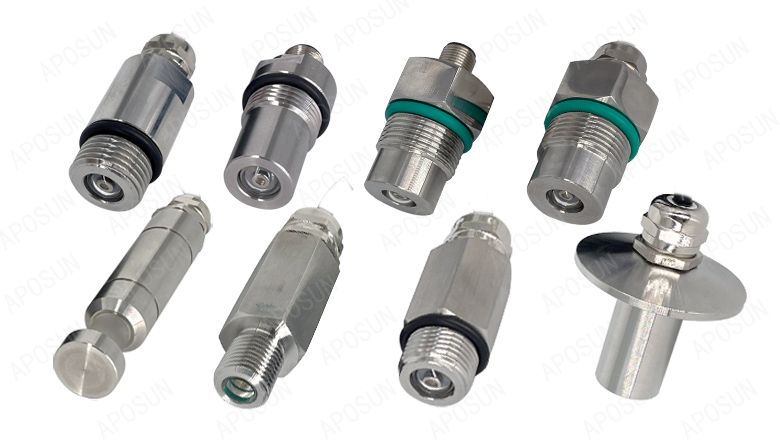What is a UV Sensor? How They Work and Why They Matter

What is a UV Sensor?
A UV sensor is a device that detects ultraviolet (UV) radiation, which is invisible to the human eye. These sensors measure the intensity of UV rays from both natural and artificial sources, making them essential in various applications, including healthcare, industrial processing, and environmental monitoring.
UV rays, which have shorter wavelengths and higher energy than visible light, can be beneficial in small amounts but harmful in excess. UV sensors help monitor and detect these invisible UV emissions, ensuring safety and optimal performance across different environments.
Types of UV Sensors
UV sensors come in various types, each based on different detection principles. The most common types include semiconductor, photodiode, and photochemical sensors. These sensors convert UV radiation into an electrical signal proportional to the intensity of the UV light. For instance, at APOSUN, we use semiconductor UV sensors to provide accurate UVC intensity measurements.
How UV Sensors Work
UV sensors detect ultraviolet light and convert it into an electrical signal or numeric output. The key components of a UV sensor include:
– Photodetector: Detects incoming UV photons and generates an electrical current proportional to the UV intensity. Materials like silicon carbide, aluminum nitride, and gallium nitride are commonly used.
– Filters: Optical filters limit the UV wavelength range that reaches the photodetector, allowing the sensor to measure specific UV bands (UVA, UVB, UVC).
– Amplifier Circuit: Amplifies the weak electrical signal from the photodetector into a stronger output voltage, with gains up to 1 million times.
– Analog/Digital Converter: Converts the amplified analog signal into a digital output for processing, assigning a numeric value corresponding to the measured UV intensity.
The photodetector works through the photoelectric effect, where UV photons excite electrons, generating an electric current. The sensor’s performance depends on the photodetector’s responsivity—its ability to convert UV photons into an electrical signal. Higher responsivity leads to better sensitivity and detection accuracy.
Types of UV Light Sensors
UV light sensors are made from different semiconductor materials, each with unique properties:
– Silicon Carbide (SiC): Detects UV light from 200-400 nm, covering UVB and most of the UVC spectrum. SiC sensors are robust and can operate at high temperatures, making them suitable for harsh environments.
– Gallium Nitride (GaN): Sensitive to 200-365 nm UV light, with high responsivity and gain. GaN sensors are known for their speed, radiation hardness, and chemical inertness.
Key Specifications of UV Sensors
When selecting a UV sensor, consider these key specifications:
– Spectral Response: The range of UV wavelengths a sensor can detect, with different sensors designed for UVA, UVB, or UVC detection.
– Dynamic Range: The range of UV intensity the sensor can measure, typically from 0.1 mW/cm² to 20 W/cm² or more.
– Response Time: How quickly the sensor reacts to changes in UV levels. Faster response times (under a second) are ideal for real-time monitoring.
How to Use UV Sensors
Proper installation, positioning, and maintenance are crucial for optimal UV sensor performance.
– Installation: Mount the sensor in a location with direct UV exposure, ensuring the photodiode faces upward. Protect the sensor from moisture and weathering.
– Positioning: Place the sensor above ground and away from surrounding objects to minimize scattering and absorption of UV rays. Keep the photodiode clean.
– Maintenance: Regularly inspect the sensor housing, validate sensor readings, and replace the UV photodiode every 2-3 years to maintain accuracy.
Advantages of UV Sensors
UV sensors are highly sensitive, durable, and cost-effective, making them ideal for various applications:
– High Sensitivity: Designed to detect even low levels of UV rays with great responsiveness.
– Durability: Built to withstand harsh conditions, UV sensors are made from rugged materials like silicon carbide and gallium nitride.
– Cost-Effectiveness: UV sensors offer excellent value for their performance, with advancements making them more affordable.
Limitations of UV Sensors
While UV sensors are powerful tools, they do have some limitations:
– Spectral Range: UV sensors detect specific UV wavelengths and may not cover the full UV spectrum (100-400 nm).
– Temperature Dependence: UV sensor readings can vary with temperature, requiring compensation for consistent accuracy.
By understanding these aspects, you can choose the right UV sensor for your application and ensure it operates effectively over time.

Leave A Comment